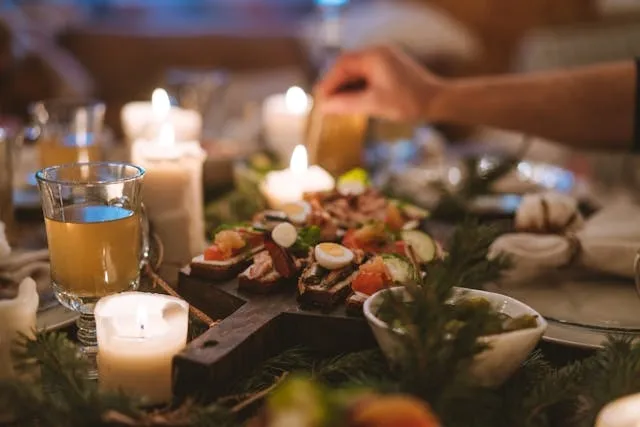Few celebrations evoke as much warmth, nostalgia, and delicious anticipation as Christmas. The holiday season brings families together around twinkling lights, heartfelt gifts, and—perhaps most importantly—tables overflowing with traditional Christmas food. But what exactly makes a dish “traditional” for Christmas? The answer varies widely depending on where you are in the world.
From roasted turkeys in the United States to minced pies in the UK, panettone in Italy, and tamales in Mexico, Christmas meals are as diverse as the cultures that celebrate them. This article dives deep into the world of traditional Christmas food—exploring its history, regional variations, and the meaning behind the festive flavors that define the holiday spirit.
The Origins of Christmas Feasting
The tradition of sharing a grand meal at Christmas stretches back centuries. Early Christian celebrations of Christmas coincided with pagan winter festivals like Saturnalia (in ancient Rome) and Yule (in Northern Europe). These events often marked the end of the harvest season, a time for communities to feast before the long, cold months ahead.
When Christianity spread across Europe, these midwinter celebrations were incorporated into the Christmas holiday. Feasting became a way to honor the birth of Christ, celebrate abundance, and strengthen family bonds. Over time, local ingredients and customs shaped the foods that became staples of Christmas tables worldwide.
Classic Christmas Foods in the Western World
Let’s begin with some of the most recognized traditional Christmas dishes in Western countries—the ones that fill cookbooks, holiday movies, and festive menus every year.
1. Roast Turkey or Goose
In many Western households, the centerpiece of the Christmas dinner is a roast bird. In the U.S., turkey—roasted golden brown and stuffed with herbs, vegetables, and breadcrumbs—takes the spotlight. This tradition carries over from Thanksgiving, making turkey synonymous with holiday feasts.
In the UK and parts of Europe, roast goose or duck was once more common before turkey became popular in the 16th century. The meat is often served with gravy, cranberry sauce, and hearty sides like roasted potatoes and vegetables.
2. Stuffing and Gravy
Stuffing (or dressing, as it’s called in some regions) is a savory mixture typically made with breadcrumbs, onions, celery, herbs, and broth. Some families add sausage, apples, or nuts for extra flavor. Gravy made from the roast’s pan drippings ties everything together—comforting, rich, and unmistakably festive.
3. Mashed and Roasted Potatoes
Potatoes, whether mashed with butter and cream or roasted until crispy, are must-have sides for Christmas dinner. In some households, sweet potatoes with marshmallows or brown sugar are also part of the feast.
4. Cranberry Sauce
Cranberries bring a tangy contrast to the richness of roasted meats. This dish, common in North America, dates back to Native American cooking traditions that influenced early colonial meals.
5. Christmas Pudding
In the UK, no traditional Christmas dinner is complete without Christmas pudding—a dense, steamed dessert made with dried fruits, spices, and often a generous splash of brandy. The pudding is aged for weeks or even months, then steamed on Christmas Day and served with custard or brandy butter.
The tradition of setting it aflame before serving (by pouring warm brandy over the top) adds dramatic flair to the holiday table.
6. Mince Pies
Another British favorite, mince pies are small pastries filled with a mixture of dried fruits, suet, sugar, and spices—once made with actual minced meat centuries ago. Today, they symbolize good fortune for the coming year.
7. Fruitcake
Fruitcake—dense, sweet, and full of nuts and candied fruits—has a reputation for being divisive, but it remains a cherished holiday tradition in many places. Some versions are soaked in rum or brandy for months, creating a deep, rich flavor.
European Christmas Food Traditions
Europe’s culinary history is woven deeply into the story of Christmas feasts. Each country has its unique take on festive fare, rooted in culture and geography.
United Kingdom
In addition to turkey and pudding, British Christmas dinners often feature roasted parsnips, Yorkshire pudding, and Brussels sprouts. Mulled wine (red wine warmed with spices) is a holiday staple, keeping everyone cozy through cold winter nights.
Germany
German Christmas cuisine is hearty and full of spice. Roast goose, red cabbage, and potato dumplings form the main meal. For dessert, stollen—a dense bread filled with fruit, nuts, and marzipan—is iconic.
Germany is also famous for its Christmas markets, where visitors enjoy bratwurst, roasted chestnuts, and glühwein (spiced hot wine).
France
In France, Christmas dinner is called Le Réveillon, meaning “The Awakening,” traditionally served after midnight Mass. The centerpiece is often roast capon, duck, or goose, accompanied by foie gras and oysters. Dessert is the bûche de Noël—a Yule log-shaped sponge cake rolled with chocolate or buttercream.
Italy
Italians enjoy La Vigilia (Christmas Eve dinner), traditionally a seafood feast known as the Feast of the Seven Fishes. On Christmas Day, families gather for pasta dishes, roasted meats, and sweet breads like panettone and pandoro—light, fluffy cakes studded with raisins or dusted with sugar.
Spain
In Spain, Christmas meals feature roasted lamb or seafood, paired with turrón (a nougat made of almonds and honey) and polvorones (crumbly shortbread cookies). Cava, Spain’s sparkling wine, flows freely at holiday gatherings.
Scandinavia
In Norway, Denmark, and Sweden, Christmas means cozy comfort food. Roast pork, meatballs, pickled herring, and rice pudding (risgrøt or risalamande) are favorites. A hidden almond in the pudding brings good luck to whoever finds it.
Christmas Food Traditions Beyond Europe
While Western countries often dominate the global image of Christmas, many non-Western regions have their own delicious and meaningful ways to celebrate.
The United States and Canada
In North America, Christmas dinners blend European influences with regional twists. In the southern U.S., glazed ham, cornbread, collard greens, and sweet potato pie often accompany or replace the turkey dinner.
In Canada, French and British influences combine—tourtière (a spiced meat pie from Quebec) is a Christmas Eve favorite. Eggnog, a creamy spiced drink often spiked with rum or brandy, is a seasonal indulgence across both nations.
Mexico and Latin America
In Mexico, Christmas (Navidad) food is rich, colorful, and full of spice. Tamales—corn dough stuffed with meat, cheese, or chili and steamed in corn husks—are a beloved tradition, often made by families together over several days.
Other popular dishes include bacalao (salted cod stew), pozole (a hominy soup), and buñuelos (crispy fritters dusted with sugar). Hot drinks like ponche navideño (Christmas punch) and atole (a warm corn-based drink) keep spirits bright.
In South America, Argentina and Brazil celebrate with barbecues, cold salads, and tropical fruits—perfect for their summer Christmas season.
The Philippines
The Philippines, home to the world’s longest Christmas season, combines Spanish, American, and local traditions. The Noche Buena feast (Christmas Eve dinner) features lechon (roast pig), hamón (sweet cured ham), queso de bola (edam cheese), and desserts like bibingka (rice cake) and puto bumbong (purple rice cake steamed in bamboo).
Australia and New Zealand
Christmas in the Southern Hemisphere happens in summer, so the traditional feast takes a lighter twist. Families enjoy cold seafood platters, grilled prawns, salads, and pavlova—a meringue-based dessert topped with whipped cream and fresh fruit. Outdoor barbecues replace fireside dinners, but the spirit of celebration is just as strong.
Africa
In many African nations, Christmas dishes blend traditional and colonial influences. In South Africa, roast meats, yellow rice with raisins, and malva pudding (a sweet, spongy dessert) grace the table. In Nigeria, jollof rice, fried plantains, and spicy stews are central to the feast, often shared among extended families and communities.
Symbolism in Traditional Christmas Foods
Christmas food isn’t just about flavor—it’s steeped in symbolism and history.
- Turkey and Goose: Represent abundance and sharing. A large bird feeds many, symbolizing generosity.
- Puddings and Cakes: Traditionally made weeks ahead, they reflect patience and preparation—values central to the Advent season.
- Spices (cinnamon, nutmeg, cloves): Once rare and expensive, these spices symbolize luxury, warmth, and the gifts of the Magi.
- Fruits and Nuts: Represent fertility, life, and prosperity during the barren winter months.
- Bread and Wine: Echo Christian symbolism of communion and gratitude.
These meanings deepen the emotional connection we feel toward Christmas meals. Every dish tells a story of faith, family, and the hope of renewal.
Modern Twists on Traditional Christmas Foods
As the world becomes more globalized, Christmas food traditions evolve. Chefs and home cooks are reinventing old favorites with creative flair:
- Plant-based feasts: Vegan roasts made from lentils, nuts, or mushrooms offer festive alternatives to meat-heavy menus.
- Fusion dishes: A British mince pie with Japanese matcha, or an Italian panettone filled with tropical fruits, reflect cultural blending.
- Health-conscious recipes: People are reimagining classics with less sugar, salt, or fat—without losing their holiday magic.
Even so, many families still cling lovingly to “the way grandma made it.” Tradition, after all, is the heart of the holiday.
Why Traditional Christmas Food Matters
At its core, Christmas food isn’t just about what’s on the plate—it’s about who’s at the table. The shared experience of preparing and enjoying these dishes connects generations and keeps family stories alive.
A grandmother teaching her grandchild to roll dough for cookies, a father carving the turkey, or friends gathering to bake gingerbread—these are more than meals; they are memories in the making.
Traditional Christmas food also reflects cultural identity. Whether it’s the spicy tamales of Mexico, the roasted goose of Germany, or the pavlova of Australia, each dish celebrates heritage and belonging. In an increasingly fast-paced world, these culinary customs remind us to slow down, gather together, and savor the season.
Conclusion: A Feast That Unites the World
So, what is traditional Christmas food? It’s a tapestry of flavors, cultures, and stories woven through centuries of celebration. While recipes differ from country to country, the spirit behind them remains the same: love, generosity, and togetherness.
From the humble loaf of bread to lavish roasts and sweet puddings, every bite carries a sense of joy and continuity. Christmas food traditions show us that no matter how far apart we live—or what we put on our plates—we’re united by the universal language of food and festivity.


